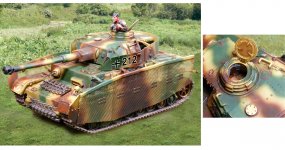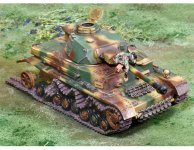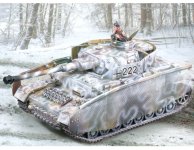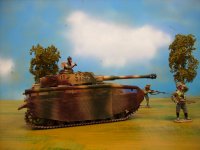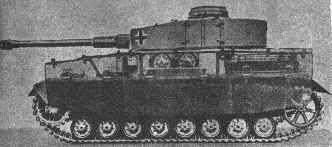Schürzen were used on the Pz.Kpfw.IV, Sturmgeschütz III and Sturmgeschütz IV and the Panther. On the Pz.Kpfw.IV Ausf.J, the thin metal sheets were replaced by a wire mesh (Thoma Schürzen). This type of Schürzen had been a competitive design to the solid plates, but the plates were initially chosen because production was easier with the existing machinery.
Schurzen began to show up about a year after the initial invasion of Russia and some months before Zimmerit. Also consider that the Tiger I design did not have schurzen. (Granted, the Tiger II fenders were specifically designed to afford HEAT protection, but really, this later design reinforces the evolving German realization of the HEAT threat.) As Paul points out, though, the protection against HEAT was serendipity. The later development of the mesh von Thoma [1] Schild and the leaving of schurzen on the Panther G are certainly evidence that the Germans became aware of the protection afforded against HEAT, but this was not the original intent. Plate schurzen gave way to "Thoma Shields" made from steel mesh, hung from metal pipes as opposed to angle iron brackets.
Thoma - or Drahtgeflechtschürzen were adopted in September 1944, starting with Pz IV Ausf. J Fgst.Nr. 92301, so any unit receiving Pz IV Ausf. J after this date should theoretically have them, although the usual first in/ last out process of assembling tanks may throw a spanner or two in the works here.
This is a direct quote from Walter Speilberger's "Sturmgeschutz & Its Variants", page 92; "the previously mentioned Schurzen side-skirts became a topic of discussion during the Fuhrer's conference on 6 and 7 February 1943. Hitler was quite in agreement with mounting the skirts on the Panzer III, IV and Sturmgeschutz to provide protection against Russian anti-tank rifles".
However, the Thoma shield style of mesh would be effective against A/T rifles and also HEAT rounds.. The size of the mesh will not allow the round to pass through it unscathed and all that’s required is to upset its flight which the mesh will do quite nicely. Tom Jentz has shown the Panther wasn’t even going to be accepted without its shields to defeat the A/T rifles. The entire Panther project was nearly cancelled because the lower hull armour was considered to weak to withstand (future?) Soviet AT-rifles. Had it not been possible to put Schürzen on the Panther, it would have been replaced by the Panther II! (See Jentz: "Panther..." p. 35 and 53)
Out of interest the cyclone fence mesh carried by AFV’s in Vietnam as anti-RPG screens worked by not detonating the round but actually shorting the firing circuit as it passed through. I have seen a training film with a dozen rounds fired and all failed to explode.
